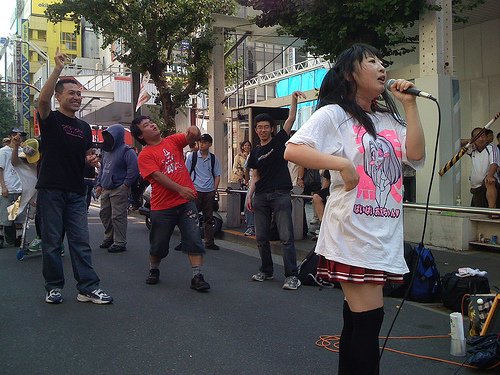I’ve written before about the psychology of ex-pats living in Japan, such as the the Three Stages of Eye Aversion we foreigners seem to go through when encountering other gaijin on the train the first few times, or our distaste for foreigners who do something rude then take the polite silence of the Japanese around them as a sign that it’s okay to keep doing it. Then there’s that odd built-in resentment of other gaijin who have been here longer than us and/or who speak Japanese better than we can, which I learned about when I came here after studying the language at SDSU for four years. This confused the Americans, Canadians and Brits I hung out with, since most of them started studying after arriving here, and they weren’t sure how to categorize me. Foreigners living in Japan can be especially jealous of the annointed “gaijin talents” who get to to be on TV just because they can be funny and/or insightful while speaking Japanese. A good example is the Egyptian fortune-teller Fifi-san, who has gotten quite a following of fans with her appearances on variety shows lately. For a wedding present my father gave me the autobiography of Donald Keene, an American translator who came to Japan soon after World War II ended and got to hob-knob with all the great Japanese writers of the postwar period, from Yasunari Kawabata to Dazai Osamu to Yukio Mishima — lucky bastard. As a general rule, any given foreigner will tend to be mistrustful of the theories put forth by other gaijin (hence, whenever someone disagrees with me I can defend myself based on this principle).

When you go to an onsen (OWN-sen), a public hot springs bath, it’s important to have all the essentials with you, and in my car I keep a basket with all my bath-related stuff in it — toothbrush, razor, large rubber bands that let me keep the shower nozzle from shutting off every 10 seconds, and a notepad for writing down all the ideas for J-List posts that come to me while soaking. I recently bought new toothbrushes, changing my normal one from blue to purple, which prompted my son to comment on my “Mace Windufication,” after the Jedi Master in the Star Wars films who uses a purple lightsaber. When I started learning Japanese, I wondered how some of the linguistic concepts we use all the time in English would be represented. Japanese is based on kanji for its higher vocabulary functions in much the same way that English is based on Latin and Greek, and complex ideas like “capitalism” or “carbon dioxide” can be rendered in kanji quite logically (資本主義 and 二酸化炭素 in case you were curious). One useful character is bakeru (化ける, to change, to transform), which is read ka in its Chinese form, and this character corresponds to the concept of “-ification” or “-ization” (i.e., a change from one state to another). Some examples of words that make use of this character are kyouka (強化、KYO-ka, strong + change) meaning “strengthen”; oubeika (欧米化, oh-BEI-ka, Europe + America + change), essentially meaning “Westernization”; and the big problem in Japan these days, shoushika (少子化、sho-SHE-ka, few + child + change), or the declining number of children throughout the country. So when my son noted the change in my toothbrush color, the word he used was “Mace Windu-ka.” Can you guess how you’d say “otaku-ification” in Japanese?
Before I got into the business of writing about Japan to people all over the world I taught ESL, and I had rather a decent horde of teaching materials accumulated, from workbooks for teaching elementary school age kids to dozens of textbooks and also a game called “English Baseball” where students were asked questions in English and would make a “hit” if they were able to answer correctly. One pre-lesson activity I liked to do was bring my favorite Far Side comics into class and start a discussion around them. As you might imagine, the jokes I thought was hilarious — “Shocking the anthropological world, a second ‘Lucy’ is discovered in Olduvai Gorge” (it’s Lucy Van Pelt), or “Great moments in evolution” (a bunch of fish have just hit their baseball up onto land and must now evolve legs if they want their ball back) received puzzled looks from my students. Clearly, what Japanese (or Germans, or Koreans) find funny won’t necessarily be viewed the same way by Americans, and I suspect Japanese would be more amused by character-based humor that blends unexpected situations for that character. The one Far Side joke that always got a laugh with my Japanese students was “Cat Showers” (a cat in a shower with a giant tongue licking his body).















